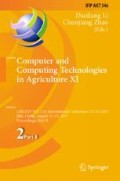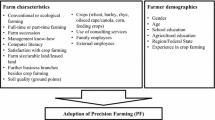Abstract
Problems of extensive and low utilization of resources exist in the traditional maize cultivation. With the rapid development of computer technology and the internet of things, this paper proposed maize precision farming parallel management technology. This technology consists of three parts: management process, model system and digital support environment construction. The objective is to realize the quantitative decision-making of maize production target-control indicators-cultivation management scheme, and realize the analysis evaluation of production environment, production technology and farmers’ operating management behavior. This technology was tested and applied preliminary in Yian County, Heilongjiang province. The application results showed that the maize precision farming parallel management technology can provide digital and scientific decision support and can achieve high production efficiency with lower fertilizer inputs and no-decreased yield.
You have full access to this open access chapter, Download conference paper PDF
Similar content being viewed by others
Keywords
1 Introduction
Northeast China is comprised of Heilongjiang, Jilin, and Liaoning provinces, accounts for 30% of the total maize production in China and is important for ensuring China’s food security. However, most of the farmers are doing the farming based on traditional knowledge. This plays a very big role in the crop production. This can’t give full play to the potential of maize production, but also may cause serious waste of resources. The extensive application of information technology, especially the model and internet of things technology in the agriculture field, brings new opportunities for informatization and digitization of agricultural production management.
Over the years, agricultural researchers have done a lot of work in resolving the relationship between environment-technical measures and crop physiological and ecological processes, and have established a series of agronomic mechanism models, knowledge models and knowledge rules [1,2,3,4,5]. Their works provide scientific theory, technical system and method means for describing the genetic characteristics of crop varieties, reflecting the interrelationship between crop and environment, as well as the purposeful, localized cultivation and management regulation, and then consequently laid good foundation for agricultural information research. Combining the crop cultivation management knowledge model with the crop growth model can achieve dynamic prediction and management decision of crop growth [6].
Internet of things is a technology that tends to connect various objects in the world to the internet [7, 8]. Applications are developed based on Internet of things enabled devices to monitor and control various domains based on applications [9]. Internet of things technology can be used to increase the crop production effectively to meet the growing needs of increasing population. Application of internet of things technology can helpful to increase the quality, quantity, sustainability and cost effectiveness of agricultural production [10].
Proper cultivation management is very important to improve the maize production. This paper introduces the control theory and method of artificial society, computational experiment and parallel execution to complex system, and puts forward the structure of precision farming parallel management system, providing a new assessment can be controlled precision agricultural management decision-making.
2 Technical Specifications for Parallel Management of Maize Precision Farming
2.1 Management Process
Maize precision farming parallel management process including four parts: planting plan and production target determination, cultivation scheme development before sowing, production warning and analysis and evaluation after harvest.
-
①
The planting plan and production target determination. According to the geographical information of the production field, the cultivation plan and the management level of the production, the maize production potential of the field was calculated by using the maize precision farming parallel management scheme design model. Then the maize production target, mainly yield target was determined.
-
②
Formulation of cultivation scheme before sowing. According to the yield target, the model of the parallel management plan of maize and the calculation method of the seed, fertilizer, water and pesticide were used to calculate and recommend the suitable varieties, sowing date, sowing density, and sowing depth, and then calculate the fertilization and irrigation schemes.
-
③
Warnings and regulations during maize growth stages. After sowing, real-time monitoring of maize growth and field environment is achieved by using Internet of Things technology and means, such as air temperature and humidity sensors, soil temperature and humidity sensors, multispectral sensors, video surveillance systems. Using design model of maize precision farming parallel management scheme to analyze whether the crop growth deviates from the optimal growth indicators. If there is any deviation or disasters occur, the computational test algorithm is used to optimize the management of irrigation and fertilization, and form a regulation scheme.
-
④
Analysis and evaluation after maize harvest. After crop harvest, the database of crop production field archives is updated. Based on the data of the current year, re-evaluation of varieties, meteorology, soil, production level and cultivation scheme and model parameter adjustment are conducted using the design model of maize farming precision parallel management scheme. On this basis, the production target and cultivation scheme for the next year can be formulated.
2.2 Model System
Maize precision farming parallel management model system consists of maize knowledge model, growth model and structural-function model. Maize structural-function model mainly used to optimize analysis and visualization output.
The maize knowledge model is developed based on understanding, analysis, extraction and integration of experts’ knowledge and experience, literature and experiment data for maize cultivation management, analyzation of the dynamic relationships of maize growth and management indices to variety types, ecological environments and production levels. The maize knowledge model is mainly designed to optimize the cultivation scheme, which includes yield target calculation, variety selection, sowing date, population density, fertilization strategy, irrigation management.
The maize growth model is based on the theory of crop-environment-atmosphere continuum. It can reflect the dynamic relationship between the maize growth and climatic conditions, management technology, soil physicochemical properties and genetic traits. The optimal cultivation management scheme based on the maize knowledge model is used as the input of maize growth model to carry out the process simulation analysis to achieve re-evaluation of varieties, meteorology, soil, productivity levels and cultivation scheme, as well as the adjustment of model parameters. Based on this, the production target and cultivation scheme of next year can be formulated.
The maize structure-function model is based on maize growth, morphology knowledge model and geometric model. It integrates the canopy radiation transfer model and three-dimensional visualization model, and realizes the canopy structure calculation, light interception, assimilation product distribution and organ growth simulation. The maize structure-function model is used to optimize the analysis and visualize the output.
2.3 Digital Support Environment Construction
Maize precision farming parallel management digital support environment includes the construction of the model database and the construction of the Internet of Thing system for real-time data acquisition.
The database construction includes geographic information, meteorological information, soil properties, variety information, agricultural materials information, farmers’ management level and field management archival information, etc. The geographic information means the location of management plot. The meteorological information includes daily maximum/minimum temperature, air humidity, sunshine duration, radiation, precipitation, wind speed. The soil properties include soil type, bulk density, wilting point, field capacity, organic matter content, total nitrogen content, available phosphorus content, available potassium content and pH value. Farmers’ management level is divided into three levels based on mechanization degree: high, medium and low. The field management archival information is the detail information of production process, including variety, sowing date, fertilizing/irrigate date and amount, etc.
The Internet of Things system for real-time data acquisition includes air temperature and humidity sensors, soil temperature and humidity sensors, multispectral sensors, video surveillance system and visible light, multispectral and infrared sensors based on unmanned aerial vehicle platform. It can provide real-time information such as crop growth, crop diseases, meteorological disasters, etc.
3 The Maize Precision Farming Parallel Management’s Application in Heilongjiang Province
The maize precision farming parallel management technology was applied in Yian County, Heilongjiang Province. The demonstration base is located in Yian Provincial Agricultural Science and Technology Park. The maize cultivated land area is about 500 mu in the park. First, the digital support environment was constructed according to the maize precision farming technology of parallel management procedures (Fig. 1). The experiment field was 10 mu, the maize was planted based on two management scheme, one is according to the maize precision farming parallel management system and another is according to local farmers’ traditional habits. The primary properties of the soil are presented in Tables 1 and 2.
According to the meteorological data and soil properties of the field plot, the maize precision farming parallel management system was used to make cultivation decision. In 2015, the yield target was made to 750 kg mu−1, and the cultivation decision was made at rain-fed conditions. The two management scheme was showed in Table 3. Compared with the farmers’ traditional scheme, the system scheme decreased the N input by 20 kg ha−1, P2O5 input by 11 kg ha−1, and increased K2O input by 11 kg ha−1.
The yield results of two schemes were showed in Table 4. Maize yield and yield components under system scheme were superior to that under traditional scheme. The results showed that the yield under system scheme was 8% higher than that under traditional scheme.
4 Conclusions
The maize precision farming parallel management technology is established base on model system and Internet of Things. Its application in Northeast China proved that the maize precision farming parallel management technology is useful to improve maize production. The system scheme made from maize precision farming parallel management technology decreased cost input and increased farmers’ profit compared with traditional scheme, and also alleviated the negative effect of chemical fertilizer on soil ecological environment. Therefore, the maize precision farming parallel management is a sustainable development technology that benefits to farmers and environment.
References
Guo, X.Y., Zhao, C.J.: The development of maize growth simulation system based on process. China Sci. Technol. Achievements 90(12), 53–55 (2004). (in Chinese)
Liang, H., Hu, K.L., Li, B.G., Liu, H.T.: Coupled simulation of soil water-heat-carbon- nitrogen process and crop growth at soil-plant-atmosphere continuum system. Trans. Chin. Soc. Agric. Eng. 30(24), 54–66 (2014). (in Chinese)
Yang, H.S., Dobermann, A., Lindquist, J.L., Walters, D.T., Arkebauer, T.J., Cassman, K.G.: Hybrid-maize—a maize simulation model that combines two crop modeling approaches. Field Crops Res. 87, 131–154 (2004)
Ahuja, L.R., Rojas, K.W., Hanson, J.D., et al.: The Root Zone Water Quality Model. Water Resources Publications LLC, Highlands Ranch, Ohios (2000)
Cao, W.X., Zhu, Y.: Crop Management Knowledge Model. China Agriculture Press, Beijing (2004)
Zhu, Y., Cao, W.X., Wang, Q.M., Tian, Y.C., Pan, J.: A knowledge model-and growth model-based decision support system for wheat management. Scientia Agricultura Sinica. 37(6), 814–820 (2004). (in Chinese)
Fan, T.K.: Smart agriculture based on cloud computing and IOT. J. Converg. Inf. Technol. 8(2), 210–216 (2013)
Hemlata, C., Sukhesh, K., Dipali, K.: Multidisciplinary model for smart agriculture using internet-of things (IOT), sensors, cloud-computing, mobile-computing & big-data analysis. Int. J. Comput. Technol. Appl. 6(3), 374–382 (2015)
Duan, Y.: Design of intelligent agriculture management information system based on IOT. In: International Conference on Intelligent Computation Technology and Automation, vol. 1, pp. 1045–1049 (2011)
Sivabalan, M., Rajan, A., Balamuralidhar, P.: Towards a light weight internet of things platform architecture. J. ICT Stand. 1, 241–252 (2013)
Acknowledgements
This work was supported by The National Key Research and development Program (2016YFD0300605-02), and the Scientific and Technological Innovation Team of Beijing Academy of Agricultural and Forestry Sciences (JNKYT201604)
Author information
Authors and Affiliations
Corresponding author
Editor information
Editors and Affiliations
Rights and permissions
Copyright information
© 2019 IFIP International Federation for Information Processing
About this paper
Cite this paper
Lu, X., Guo, X., Fan, J., Luo, S., Song, Y., Li, C. (2019). Maize Precision Farming Parallel Management Technology and Its Application in Northeast China. In: Li, D., Zhao, C. (eds) Computer and Computing Technologies in Agriculture XI. CCTA 2017. IFIP Advances in Information and Communication Technology, vol 546. Springer, Cham. https://doi.org/10.1007/978-3-030-06179-1_22
Download citation
DOI: https://doi.org/10.1007/978-3-030-06179-1_22
Published:
Publisher Name: Springer, Cham
Print ISBN: 978-3-030-06178-4
Online ISBN: 978-3-030-06179-1
eBook Packages: Computer ScienceComputer Science (R0)






